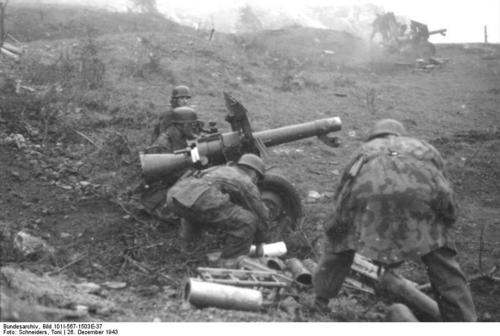
| Year | 1942 |
| Weapon Type | Light Recoilless Gun |
| Origin & Designer | Germany/Krupp |
| Numbers Produced | 420 (Both Models) |
| Crew | 4 |
| Calibre | 105mm (105x155R) |
| Elevation | -15° to +42° |
| Traverse | 60° or 360° (Depending on Elevation) |
| Breech | Horizontal Sliding Block |
| Recoil | [@recoil] |
| Gun Sight | Rbl.F.40 |
| Gun Mount | Box |
| Carriage | Twin Wheeled / Box Trail |
| Trailers | [@trailers] |
| Gun Shield | [@gun_shield] |
| Armoured Plate | [@armoured_plate] |
| Barrel Length | 1.380mm (L/13) |
| Overall Length | 1.90m |
| Width | [@width] |
| Height | [@height] |
| Weight | Weight in Traction: 476 kg Weight in Action: 431 kg |
| Round Weight | 12.25 kg |
| Muzzle Velocity | 335 m/s |
| Feed | [@feed] |
| Magazine Capacity | [@magazine_capacity] |
| Practical Rate of Fire | [@practical_rate_of_fire] |
| Rate of Fire | 7 r.p.m. |
| Maximum Rate of Fire | [@maximum_rate_of_fire] |
| Maximum Ceiling | [@maximum_ceiling] |
| Maximum Ground Range | [@maximum_ground_range] |
| Maximum Range | 7.950m |
| Armour Penetration | 90mm @ 500m @ 30° |
| Traction | Pack (four loads) & Motorised (Kettenkrad Sd.Kfz 2) |
| Variants | 10.5cm LG 40/2 Notes: Exactly the same as the LG 40/1 except the carriage was made out of steel and not light alloy. |
| Notes | After the invasion of Crete the German military saw the usefulness of the 75mm LG40 in action and decided on a larger version to supplement the 75mm weapons. This resulted in the development of the 105mm LG40. It fired the same type of ammunition as the 105mm leFH 18 and was made using light alloys. The whole gun could be parachuted in one load or dropped in five small loads. Later versions were built out of steel due to the lack of aluminium. It served in independent batteries and some were issued to 1st cavalry division. Like the 75mm LG40, the 105mm LG40 served right through the war. |